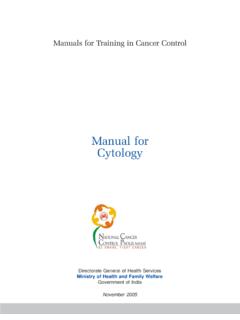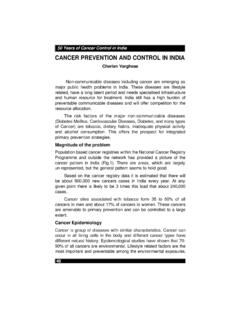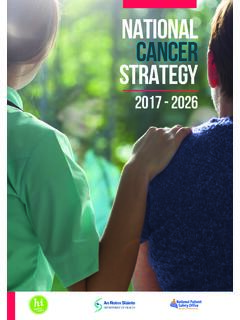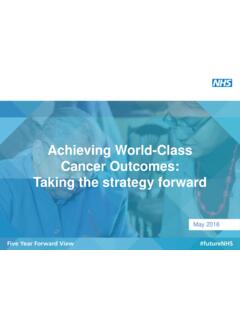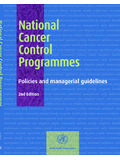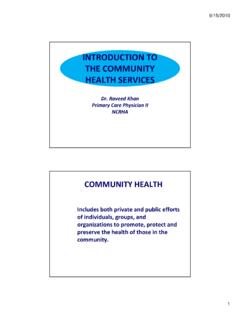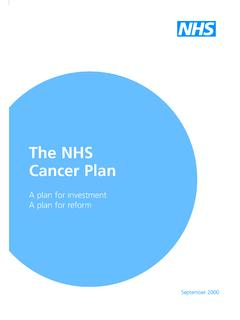Transcription of Cancer services recovery plan - NHS England
1 Classification: Official Publications approval reference: 001559 NHS Cancer programme Cancer services recovery plan 14 December 2020 2 | Cancer services recovery plan Background and purpose The coronavirus pandemic has presented major challenges for all healthcare systems. One of the most significant impacts was a sharp reduction in the number of people coming forward and being referred urgently with suspected Cancer and referred from screening programmes. When coronavirus prevalence was at its highest at the start of the pandemic, this resulted in some people facing longer waits for diagnosis, some treatments being delivered in different ways or being interrupted or stopped on the grounds of clinical safety, and some follow-up care being disrupted. Yet, thanks to the efforts of NHS staff and their partners, including many staff and volunteers in the Cancer charities, the number of people receiving first or subsequent treatment was maintained at 86% of that in the same period in 2019 (March to September).
2 The response to the pandemic by NHS Cancer services has focused on three phases (see Appendices B to D for further detail): Phase 1: ensure continuation of essential Cancer treatment and screening for high risk individuals during the initial peak of the pandemic. Phase 2: restore disrupted services as far as possible to at least pre-pandemic levels. Phase 3 (to run until March 2021): full recovery of NHS Cancer services in England , including ensuring that care for all patient groups continues to be safe, effective and holistic. This document sets out the national NHS plan to deliver this third phase. (See Appendices D and E for information on roles, responsibilities and governance for delivery of the plan .) Equality and Health Inequalities Statement Promoting equality and addressing health inequalities are at the heart of NHS England and NHS Improvement s values. Throughout the development of the policies and processes cited in this document, we have: Given due regard to the need to eliminate discrimination, harassment and victimisation, to advance equality of opportunity, and to foster good relations between people who share a relevant protected characteristic (as cited under the Equality Act 2010) and those who do not share it; and, Given regard to the need to reduce inequalities between patients in access to, and outcomes from healthcare services and to ensure services are provided in an integrated way where this might reduce health inequalities.
3 3 | Cancer services recovery plan The current picture The principal reason for a reduction in the number of Cancer patients commencing treatment was the fall in referrals. Urgent referrals The number of people seen following an urgent referral for Cancer fell in April 2020, but by September had returned to 199,801 (102% of normal). Waiting times The number of people waiting more than 62 days for diagnostics and/or treatment following urgent referral has fallen by more than half but remains above the pre-pandemic level of about 11,800. This number peaked in May 2020 but by September had fallen to below 20,000, with continuing improvement. By tracking this number we can monitor the capacity of the system for diagnosis and treatment, and support regions and local systems if there is any suggestion they have insufficient capacity to meet demand. Screening The NHS breast and bowel screening services were locally paused in March 2020, but all services are now running across the country.
4 The bowel screening programme is issuing screening invitations at rates over 100% of pre-COVID rates. There is still work to do to ensure the capacity is in place to manage patients that have experienced a delay during Covid-19. Treatment Most Cancer treatment was maintained throughout the initial peak of the pandemic, although the need to protect patients from coronavirus infection and to manage the pressure on investigations, acute and critical care did disrupt pathways. Over 291,000 people received their first or subsequent treatment for Cancer during this time (March to September 2020), 86% of the number treated in the same period in 2019. Over 150,000 people started their first treatment. This is around 30,000 fewer than in the same period last year, largely as a result of fewer referrals. Significant work has gone into encouraging people to come forward. 4 | Cancer services recovery plan The Cancer recovery Taskforce This plan has been developed with the Cancer recovery Taskforce, which is chaired by Professor Peter Johnson, national Clinical Director for Cancer , and includes representatives from Cancer charities, royal colleges, national teams and the NHS Cancer programme s Patient and Public Voices (PPV) Forum (see Appendix G for full membership).
5 The taskforce s focus is the recovery of Cancer services , and it reports to the national Cancer Board which oversees the delivery of the NHS Long Term plan ambitions for Cancer to diagnose 75% cancers at stage 1 or 2, and for 55,000 more people to survive for five years or more, by 2028. The taskforce s roles are to: review progress against the aims of the recovery plan monthly, reporting to the national Cancer Board identify any requirements for the successful recovery of Cancer services that are the responsibility of stakeholders outside the NHS Cancer programme (eg public awareness, Cancer screening, infection control measures) understand and represent the needs of patients and their families, and NHS staff, and engage with the wider Cancer community on the national delivery of the recovery plan and its progress share practical suggestions about what the wider Cancer community can do to support recovery . The taskforce provides advice and guidance on national strategy for the recovery of Cancer services .
6 It also has an important role in representing the views of the Cancer community in the wider national recovery strategy beyond Cancer services , eg shielding. The taskforce is monitoring progress against the aims of restoring demand, reducing waiting times and ensuring sufficient capacity for Cancer diagnosis and treatment. Operational delivery resides with regional teams and STPs/ICSs, led and supported by the Cancer alliances. 5 | Cancer services recovery plan plan on a page Aim 1. Restore demand to at least pre-pandemic levels Aim 2. Reduce number of people waiting longer than they should Aim 3. Ensure sufficient capacity to manage future demand Run a major public awareness campaign Ensure efficient routes into the NHS for people at risk of Cancer , including through supporting restoration of screening programmes Improve referral management practice in primary and secondary care Audit and focus on longer waiters Implement urgent plans to increase/manage demand for endoscopy and imaging capacity Implement best practice and modified pathways to account for impact of COVID-19, and ensure patients are seen as quickly and as safely as possible Maximise use of available capacity (on both screening and symptomatic pathways) through system-wide working Optimise use of available independent sector capacity Enable restoration of other services Take action to protect service recovery in preparation for winter We will achieve these key aims by.
7 Supporting a system-first model through alliances Alliances working through and with local systems in an integrated way Single dataset at national , regional and local system level on referral, treatment and longer waiter numbers Monthly check-in rhythm with regions to ensure appropriate support and prioritisation is in place Tackling inequalities Monitor referral and treatment metrics by deprivation or ethnicity as data permits Target public awareness campaign in line with data Ensuring public and staff confidence Promote implementation of national guidance on maintaining COVID-19 protected environments, including use of PPE and testing of staff and patients Communicate with patients and the public on steps being taken to ensure safety Locking in innovations Consolidate evidence-based innovations developed as a result of the pandemic Focus 2020/21 Innovation Fund on technologies to support recovery Ensuring the right workforce is in place Support returners and volunteers to help Cancer recovery Work towards reducing any gaps in the workforce and support existing staff to continue to deliver care Training bursaries for clinical nurse specialists and chemo-nurses Restarting LTP activity that supports recovery Prioritise Long Term plan commitments that will support recovery , including rapid diagnostic centres, bowel screening, targeted lung health checks and personalised stratified follow-up Ensuring effective communications Host regular webinars with the Cancer charities and Cancer clinicians Hold fortnightly calls with the Cancer alliances.
8 And regular meetings with the PPV Forum 6 | Cancer services recovery plan Success measures Our success measures show what we want to achieve against each of our three aims. Aim Success measure Measurement 1. Restore demand coming into the system to at least pre-pandemic levels The number of patients to be seen in a first outpatient appointment following urgent GP referral will have returned to at least pre-pandemic levels Monthly Cancer waiting times data at national level (published) Note: Progress on restoring screening programmes will continue to be measured and monitored through the national Cancer screening programme boards 2. Reduce the number of people waiting longer than they should for diagnostics and/or treatment at least to pre-pandemic levels on both screening and symptomatic pathways The number of patients waiting more than 62 days after urgent referral will have returned to at least pre-pandemic levels Monthly snapshot of the patient tracking list (PTL) at national level (published) 3.
9 Ensure sufficient capacity to manage future increased demand, including for follow-up care The number of patients receiving first definitive treatment following a decision to treat will have returned to at least pre-pandemic levels Monthly Cancer waiting times data at national level (published) Where our data identifies issues with the progress being made, we will continue to work with regional teams to understand what they and their local partners are doing to respond, and will agree additional actions and support where necessary to ensure we see progress in all areas. Ensuring we address unmet need The drop in number of first treatments for Cancer since the pandemic began indicates that some people who have Cancer have not yet gone to their GP with symptoms or had a screening appointment. The NHS is acting to increase presentations to GPs and restore all Cancer screening programmes. 7 | Cancer services recovery plan As we monitor the number of people receiving first treatment at national , regional and alliance level we need to see the system catch up with this unmet need, and by monitoring the waiting list over 62 days from urgent referral to see that capacity is sufficient to diagnose and treat all these people.
10 8 | Cancer services recovery plan Planning for winter COVID-19 infections in the community and hospitalisations are rising at different rates across the country, but as we approach winter we must stay focused on delivering the national plan for the recovery of Cancer services by March 2021. We will continue to monitor progress across the country, with additional support offered to areas as they experience increased capacity challenges. To help prepare for winter, we are asking Cancer alliances to: Maintain COVID-protected environments for Cancer Ensure clear escalation plans are in place, with redeployment of staff involved in Cancer screening, treatment and care considered only as a very last resort. Maintain or step back up Cancer hubs for Cancer surgery in line with existing advice. Use hub arrangements to protect capacity for endoscopy where possible. Maximise the use of independent sector capacity for Cancer . Test non-symptomatic staff directly involved in the treatment and care of patients in Cancer services on a weekly basis.










